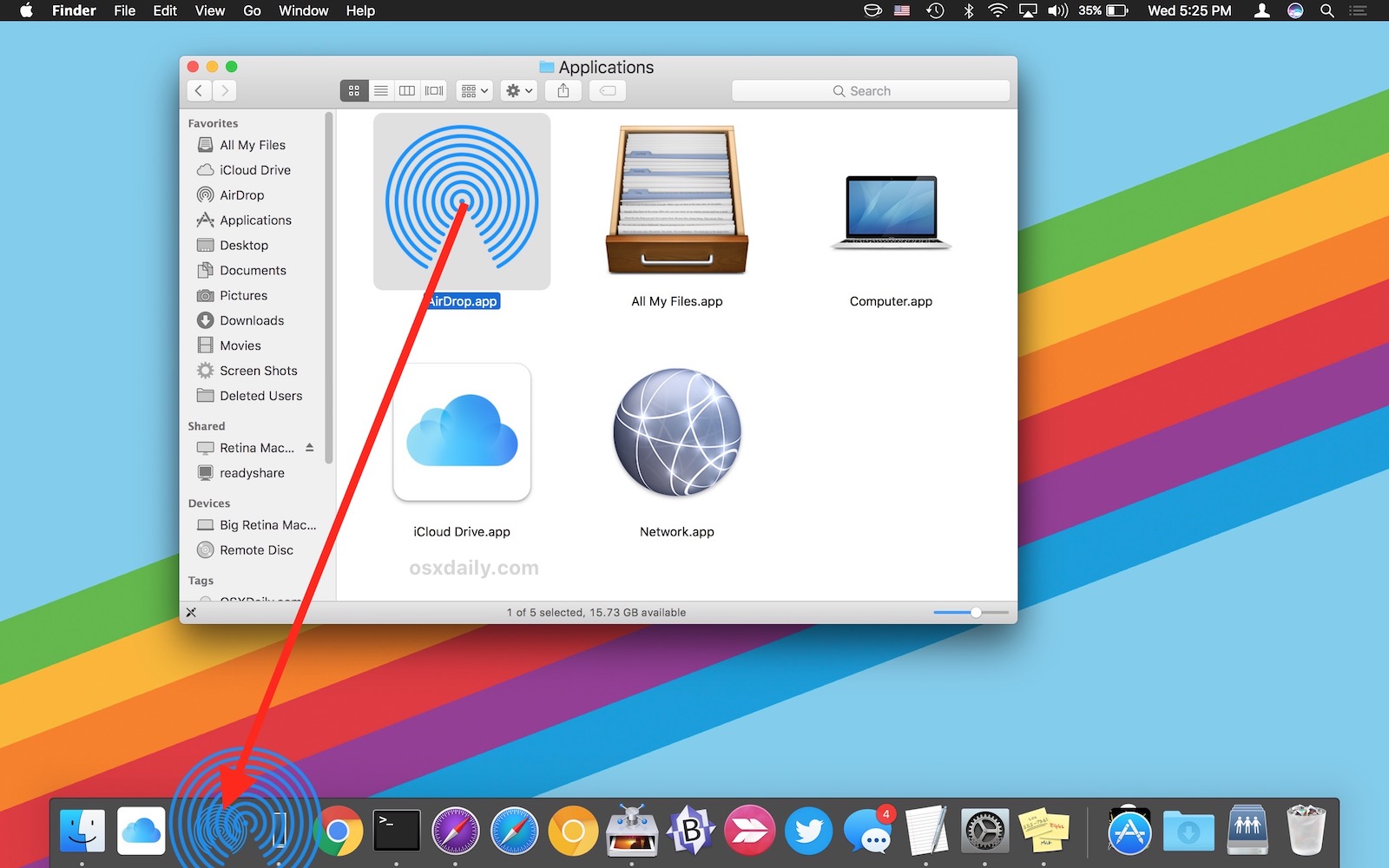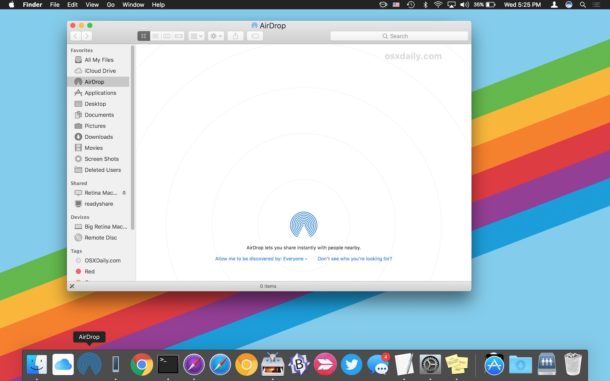How to Add AirDrop to Dock on Mac for Rapid Access

If you frequently use AirDrop on the Mac to send and receive files between Macs or to and from iOS devices, you may appreciate having ultra-fast access to AirDrop by having it readily available from the Dock of Mac OS.
By using a little file system trick, you can gain direct access to AirDrop through the Mac Dock, rather than having to use the Finder to navigate to the file sharing feature. This guide will walk through how to set that up on Mac.
Obviously the Mac must support AirDrop to be able to use the feature, let alone have access to it. Nearly every vaguely modern Mac supports AirDrop, and all modern MacOS operating systems support the feature, so as long as you’re reasonably up to date then compatibility shouldn’t be an issue. Adding an AirDrop icon into the Dock of the Mac is achieved by locating a shortcut to the AirDrop feature and then placing it into the Dock. This is hidden by default within a system folder, but it’s easy to retrieve with the following steps:
How to Add AirDrop to the Dock on Mac
- Open the Finder of Mac OS
- Pull down the “Go” menu and select “Go To Folder”
- Enter the following directory path exactly, then hit Enter / Return to jump to that location in the file system:
- Find the “AirDrop.app” application within the directory, then drag and drop Airdrop.app into the Dock of the Mac, arranging it for where you want the icon to be accessible
- Close the /CoreServices/Finder.app/Contents/ folder when finished
![]()
/System/Library/CoreServices/Finder.app/Contents/Applications/


Now if you click on the AirDrop icon in the Mac Dock, an AirDrop window will open immediately in Finder to activate the feature, making AirDrop on the Mac ready to send and receive.

Remember, AirDrop can work to send data to and from Macs, as well as to and from iOS devices. If you’re unfamiliar with data transfer using AirDrop, the following walkthrough guides should be helpful to you:
- Mac to Mac: How to use AirDrop on a Mac to send files to other Macs
- Mac to iOS: How to use AirDrop to send from a Mac to iPhone or iPad
- iOS to Mac: How to use Airdrop to send files and data from iPhone or iPad to a Mac
It’s also helpful to recall that where AirDrop files go depends on the target recipients operating system, on the Mac that’s always the Downloads folder of the active user account, but in iOS it can be various places depending on the file type being sent.
Ultimately the AirDrop window accessed from the Dock this way will be the same AirDrop window you’d access in Finder when clicking on ‘AirDrop’ in the sidebar menu, or from the Go menu, or via the AirDrop keyboard shortcut, it’s just a matter of ease and speed that make adding the AirDrop icon to the Dock a helpful trick.
You may notice this is similar to how you go about adding iCloud Drive to the Mac Dock, and so while you’re performing either trick you could add another step to include that as well if it interests you.
AirDrop offers one of the easiest ways to share files between Macs and is certainly worth understanding how to use, so d


How can it be that Airdrop ONLY defaults to Downloads folder? We should be able to direct where the airdrops go! Once again Apple engineers give us “cool” without thinking it through to make it PRACTICAL. I Googled and some folks have developed a two page, 13 step process with hints that it messes up your System disk. NOT helpful.
Using AirDrop is about a 2 step process: open AirDrop, send files / receive files. It is not a 13 step process nor does it do anything with your “System disk” other than either send or receive files from there, by your choosing.
AirDrop files go into the Downloads folder by default, yes. You can read more about where AirDrop files go here:
https://osxdaily.com/2017/01/20/where-airdrop-files-go-located/
On my iMac (Sierra) the folder “can’t be found”!
Just as easy and for less clutter on the dock is cmd-space bar and then “aird”, which will bring up the airdrop result, then press Enter/Return and voilà, Airdrop is open.
Some of those other applications in that folder are also handy in the Dock too!
I am on El Capitain. This file does not exist on my Mac. :(
Perhaps you should upgrade. The longer you go without getting current, the more chance you have of not getting security updates. Apple doesn’t issue security updates for older macOS versions after a certain point.
Or perhaps he’s fully justified in sticking with El Cap, which does continue to receive timely security updates from Apple.
As a longtime Mac user and tech professional, I continue to prefer 10.11 for my daily tasks, because it supports third-party tools that are useful to me and that haven’t been updated to run under 10.13.
As the article notes, AirDrop is available on a broad assortment of Apple hardware and OS versions, so the tip certainly should be amended, either to indicate that it applies only to certain OS versions, or to include parallel instructions for earlier versions.
You can get the Airdrop icon much faster in the dock: Use Spotlight, then type ‘Airdrop’.
Dubbelclick on that Airdrop Icon en the Mac takes you to the position of Airdrop in the Applications folder.
Then you can put it from there into the dock. Finished.
This is correct. Much easier. This article should be cancelled and this solution mentioned. Type into spotlight and drag to dock. Two steps!!!
I have and frequently use AirDrop on my Macbook Pro. I have typed in ‘/System/Library/CoreServices/Finder.app/Contents/Applications/’ into Go to Folder several times but get ‘The folder can’t be found’.Any idea why please?
Where can I grab that wallpaper?
If you’re on macOS High Sierra, it’s already on your Mac.
Shift, Command, R key combination while in Finder/Desktop, summons AirDrop a lot faster. This is a good tip though. Shift, Command, I key combination summons iCloud Drive.
What’s that app to the right of the Air Drop icon?!!
It’s iCloud Drive. They posted a hint on how to put it in the dock about a week or so ago. It’s located in the same place where you’re dragging AirDrop from.
To the left is icloud, to the right is Activity Monitor, something this author seems to leave running all the time – it shows up in a lot of the screen shots.
Hmm … Did Apple change the Activity Monitor icon from Sierra to HS?
No, he is using the custom CPU Usage Dock icon for Activity Monitor. It can be found under View > Dock Icon in Activity Monitor.